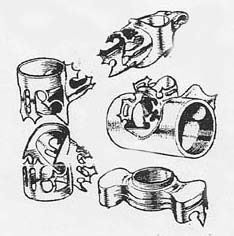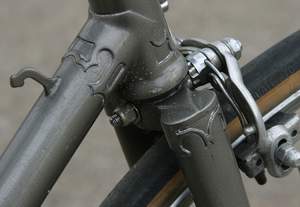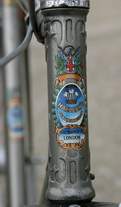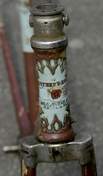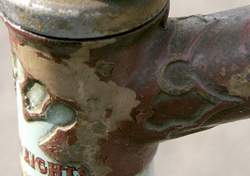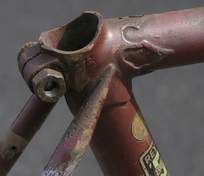Macleans Featherweight Cycles
Posted: Tuesday 02nd June 2020
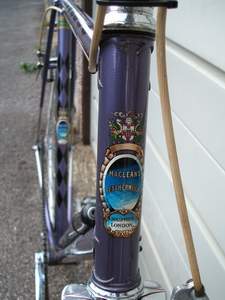
Don Maclean formed the company sometime prior to 1922 and may well have been assisted by his later partner Harry Bailey. V-CC member Nick Tithecott has a part of the packaging which once contained 2000 “Jackson Rd.” transfers; this bears the date December 1922 and may well have been the first batch of formal transfers for the fledgling company.
They were based 39 Landseer Road prior to 1922, when the company moved to 2 Jackson Rd, Holloway, London N7. IN 1928 they acquired additional premises nearby in 366 Upper St. (extends south of Holloway Rd.) From 1929 to 1933 they were using only the 366 Upper Street premises.
Adverts found in the January 9th 1925 and August 14th 1925 issues of Cycling magazine for the Featherweight Cycle Co. range of complete cycles show the company trading at 366 Upper St. This would indicate that Macleans took over the Lightweight Cycle Co. and soon after incorporated the word “Lightweight” into their own title. By September 1926 an advert shows Maclean’s Featherweights being advertised.
Mick Butler found this piece relating to 1926
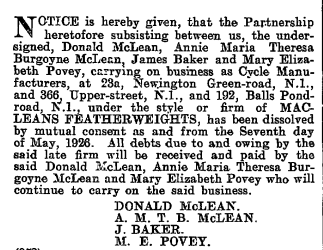
In 1934 they moved a few doors up the road to occupy 362-3 Upper Street, where they remained until the business was wound up in 1962 and passed into the ownership of Holdsworthy Cycles.
Holdsworthy produced small numbers of “Maclean” badged cycles throughout the 1960’s, these being re-badged versions of their own range of frames. Thus a 1960s Maclean frame could also be found with Holdsworthy or Claud Butler badges.
An undated sales catalogue describes the company as – “Specialists in building to customer’s detailed specifications”. They were “Actual manufacturers of high class racing, touring, lightweight cycles and tandems”. All their frames carried a 10 year guarantee. In small print they also claimed – “We are the oldest firm in the lightweight cycle industry”.
List of company premises:-
| Prior to 1922 | 39 Landseer Rd., Holloway, London N.19 |
| 1922-1928 | 2 Jackson Rd., Holloway, Londn N.7 |
| 1926-? | 192 Balls Pond Rd., London N.1 (Reg. Offices & Factory) |
| 1926-? | 2 Jackson Rd. & 366 Upper St. Islington, London N.1 |
| 1929-1933 | 366 Upper St. Islington, London N.1 |
| 1937-? | Sales & Service also at:- 258 High Rd., Tottenham, London N.1 |
| 1934-1962 | 362-3 Upper St., Angel, Islington, London N.1 |
Model range
An early, unillustrated, pre-war catalogue from the 366 Upper St. days lists the following available models:-
| "Club" model | £2:6:0 |
| Complete "Rigid Road Race Cycle" - Ladies or Gents | £5:5:0 |
| Brampton "Tandem Race" frame or complete cycle | £11:11:0 |
The limited range is augmented by a wide range of build options and accessories; as well as their “specialising in building to customer’s own measurements”.
Another undated, probably pre-war, catalogue from the 362-3 Upper St. premises lists an extended range based on the earlier options:-
Frames –
| "built to your detailed specification" | £3:10:0 |
| "Club Model no.1" | £7:10:0 |
| "Touring Model" | £9:10:0 |
| "Ladies Sports Model" | |
| "Club Tandem" | cross-over drive, or, double-diamond pattern if preferred. |
| "Touring Tandem" | £14:14:0 to £16:16.0 |
A slightly later, undated, early post-war catalogue lists an extended range with modest price increases:-
| Frames (standard & upright models) | £3:15:0 |
| "Club Model No.1" | £8:0:0 |
| "Mac Super Model" | £11:10:0 |
| "Touring Model" | £9:10:0 |
| "Ladies Sports Model" | £8:0:0 |
| Tandems "Cross-over drive" | £16:16:0 |
| "Touring" | £16:10:0 |
| "Club" | £14:14:0 |
Another updated catalogue sent to a Mr. Saunders by Harry Bailey from Macleans – letter dated 29th July 1952 – lists models and prices:-
| Track or Path frame | £12:10:0 |
| "Eklar" model | £38:0:0 |
| "Club" model | £25:6:8 |
“Apollo” model – is mentioned in an article London Builders at Home 9th November, 1950. “An Apollo bicycle, the feature of which is the intricate and finely finished cutout lugwork.” possibly the first time the Apollo was launched on the public. A later article in Cycling magazine, dated January 15th, 1953, illustrates the lug-work on the Apollo model (see image below) . The Apollo was not mentioned in the 1956 catalogue. (Peter Underwood)
Len Phipps, owner of frame number KA996, which dates from early 1950 sent in a detailed drawing of the intricate lug-work, referring to it as an “Apollo” model. At this early date it could have been an example of a customer’s personal specification; in the absence of any available catalogue references to the Apollo model, it must remain as being a special build option that the company chose not to advertise widely.
An updated catalogue, probably from the mid 1950’s (head clips no longer shown) lists a limited range with the noticeable absence of a tandem in the illustrations:-
“Track or Path Frame” – or can be built as Road machine £12:10:0
“Eclipse” cycle – frame or complete build, with a variety of accessories. Frame £15:0:0 or complete build £36:0:0
“Club” cycle or frame. Frame £11:10:0 or complete £26:16:0
Staff at Macleans
At the bottom of each page in the pre-war catalogues are written one-line statements relating to the way the business is run; such as:- “Our Super Salesmen-Our Products”, and more to the point, “No Figureheads at Macleans – Only Mechanics”!
The staff were well known to customers and to a wider public for their skills. An article in Cycling Weekly dated February 26th 1994 refers to several employees – “Robert Badger worked at the shop in Upper Street in Islington and now trades as Roberts Rebuilds in Crouch End. Pat Hanlon, who later had a shop in Bowes Roadn was their wheelbuilder”.
Another former employee, Norman Penstone, who worked for the company between 1957 and 1961, said that the shop in Seven Sisters Road was only a retail outlet and that the frames were made in Camden Passage, Islington, behind the main shop at 362-3 Upper Street, Angel. He lists the staff as:-
| Shop Owners | A Wolfe and Norman Taylor |
| Shop Manager | Joe Pearson |
| Mechanics | Alan Macher, Norman Penstone and Bob Badger |
| Temporary Mechanic | Cliff Nyman |
| Frame Builders | Fred Tarsley and John Marriot |
Norman also remembers :- “When Dick Swann arrived (as manager in 1961) he brought in new technology – malleable cast lugs. He tried hard to get the owners to sell more lightweight equipment but his words fell on deaf ears. Alan Macher was with ‘Macs’ from 1952 until they closed; he is now retired and living in Bournemouth (2004).”
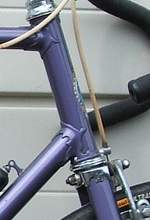
He continues:- “Pat Hanlon had just left when I arrived (1957) but I got to know her through Alan, who was a good friend of hers. She was recognised as the best wheelbuilder of her time. The frames were manufactured in Camden Passage premises behind the main shop. There were four models on sale: Arcadian – Club – Eclipse and Super Eclipse.
A customer named G Keeley owned a Maclean 50 years ago (1940s) and remembers that Jack Lauterwasser, the great pre-war triallist, built frames at the Holloway Road workshop.
Another customer, Derek Waters, born in Tottenham, owned a Paris road/race frame but still bought his clothing and parts at the shop because they were close to home and stocked an extensive range of wheels, tyres, accessories and clothing, etc.
He remembers the two large double-fronted shop windows in Upper Street with the entrance through the left-hand doorway. As you entered the shop the access to the workshop was in front of you. Frames were displayed in the right-hand windows, with accessories and clothing on the left-hand side. The shop was dark inside with brown paint and a long wooden counter covered with fawn lino that extended the full length of the two shops. Inside the shop a range of complete bikes were available which included roadster and touring models from other well-known makers such as Rudge. A wide range of specialist fittings were available from makers such as GB and Airlite.
The exterior of the shops was also painted brown/red with the name ‘MACLEAN’ in large gold letters above the windows. Because the road sloped gently downhill you had to step up into the shop. Derek recalls that Macleans catered more for the tourist market; you would not see groups of road/race riders hovering outside the shop in the same way they gathered outside the nearby shops of Hetchins or G.W. Lightweights (built by Len Glover).
Head and Seat Tube Transfers
The original transfer (possibly an “off the peg” design) featured an oval, hatch in blue, grading from dark to light from top left to bottom right. The oval is contained within a wreath effect border. At the bottom is a small ornamental panel. The words “D. Maclean, 2 Jackson Rd. Holloway” were inscribed on five lines within the large oval and the worlds “London N7” on one line in the small bottom panel. When he became the sole proprietor it is believed the Harry Bailey removed the “D” after Don’s death in the mid-20s.
The most commonly seen transfer, used on restored cycles, feature the transfer used in 1928-33 “366 Upper St.” period. This transfer retained the wreath-bordered oval which now contained the wording “Maclean’s Featherweight” on two lines, the latter word being curved downward. In the small bottom panel appear the words “366 Upper St. London” on two straight lines. The oval badge is now surmounted with the splendid London Coat of Arms.
When the company moved to 362-3 Upper St. the transfer was changed again. The oval now contained a Fleur de Lys coronet above the upward curving worlds “Maclean’s Featherweight” on two lines. The small bottom panel contained the words “362-3 Upper St. London” on two lines. The crowning London Coat of Arms was simplified by the removal of the Fleur du Lys from the centre of the Cross of St. George shield. Still a very impressive badge but no longer quite as stunning as the earlier versions from 2 Jackson Rd. and 366 Upper St.
No further head and seat tube transfers have been recorded to date.
When the company was transferred to Holdsworth Cycles a completely new metal headbadge was designed and remained unchanged until the demise of the name.
The Holdsworthy metal badge consisted of a rounded oval with a simplified wreath border and a simple coronet at the top. The interior has a black background with the word “Featherweight” across the top part and the word “Cycles” at the bottom, both in gold. In between, diagonally across the centre of the oval, the word “Maclean” is printed in large gold capitals on an orange/red background, bordered top and bottom by a gold strip. Along the bottom of the oval is an oblong panel with a step base and fluted ends. The interior of the panel has a green background upon which are the words “London S.E.20” in gold capitals. The badge has mounting pins top and bottom. A transfer version of this badge is used on the seat tube – complete with marked pin holes!
Down Tube Transfers
There are no records of the evolution of the transfers used on each side of the down tube. It would appear that pre-war frames only had the simple word “Maclean” in silver or gold capitall letters on each side of the tube.
After the war in the late 1940s the above transfer was replaced with the attractive “MAC — LEAN” transfer in large gold block capitals with a motif in between the two parts (where the dash is placed). This consisted of a round wreath with the letters “Mac” inside on a red background. A pair of silver outstretched ‘angel’s wings’ radiate from the central wreath. Above the wings is the word “Featherweights” in small gold capital letters; while below on two lines are the words “362/3 Upper Street” and “Angel N.1” These two lines are in small silver block capitals.
Also seen on a few cycles is a simpler transfer with the word “Macleans” in dark blue or red scrolled capitals. Each letter with a white/black border on a plain white background; behind which is another elongated background in pale blue with a silver outer edge tapering to a point at each end. This transfer is on both pre and post-war machines.
Frame numbering and dating
At the time of writing there are no known records or proven information regarding the numbering of frames, both pre and post-war. However, there are adequate known numbers of post-war frames which have bills of sale that have allowed the verification of the numbering system used post-war.
Pre-war dating
To date there are so few confirmed dates of manufacture or sale to be able to date any other frames from this period. The known numbers listed below indicate how difficult it is to attempt to construct a number dating pattern.
Pre-war cycle numbers, as provided to date, all 1930’s?
| DE517 | Restored, in black, by Holdsworthy Cycles |
| DE928 | On a frame now in Ottawa, Canada |
| EE212 | Thought to be 1934 |
| EE430 | A tandem seen in an advert in 1983 |
| EE498 | A tandem |
| EE871 | Double gents tandem - resprayed maroon |
| B798 | Spring 1937. A black, double gents tandem, bought new |
| B822 | An unrestored tandem |
| C461 | A tandem trike, advertised as c. 1938 |
| C484 | Unrestored |
| E267 | Family owners stated that it was bought 1935/6 |
| G664 | Unusual down tube transfers |
| M17 | A frame renovated in the 1950's? |
| N41 | Original duck egg blue (tandem) |
| W105 | 1936/7? |
| W265 | 27th april 1938 bill of sale - a "Super Cycle" model |
| W798 | Bought new in 1939 |
| W888 | Solo |
| W983 | Tandem, bought from original owner |
Post-war dating
There are adequate post-war verified numbers to be able to date frames quite accurately. After the war the company started to use a numbering system that started with the prefix letter “K”, followed by numbers, which did not go beyond 999. There are no records yet of four figure numbers following the letter prefix. Once the numbers reached 999 the company went on to use the prefix “KA”, followed in sequence over the years by “KB, KC, KD, KE”. There are no known recorded letter combinations beyond “KE”.
It is important to mention at this point the fact that there are cycles currently in use that carry “Maclean” transfers, both pre- and post-war, that are not Macleans. It is relatively easy to come by the transfers and put them on a frame that the owner thinks is a Maclean but if the frame does not carry the trademark form of letter/number numbering then it is not a Maclean. The frame number is usually to be found at the top of the seat tube. On some frames it is also stamped on the inside of the steerer tube. It can also be found under the bottom bracket or on the side of rear fork end.
Post-war frame numbers:-
Listed below are known and proven dated numbers:-
| K23 | March 1946 |
| KA26 | Before 14th June 1948 |
| KA57 | February 1948 |
| KA79 | April 1948 |
| KA574 | May 1949 |
| KA699 | 9th May 1949 |
| KB61 | 1950 |
| KB123 | 11th March 1950 |
| KB905 | 14th June 1952 |
| KC978 | 1955 |
| KD200 | 1956 |
| KD213 | 29th September 1956 |
| KD573 | April 1958 |
| KD909 | May 1959 |
All frame numbers supplied to the marque register to date are set out below. The current whereabouts of all these frames is not known because, in many cases, the registrar was asked to date a frame prior to its sale:-
K23 – K56 – K107 – K164 – K165 – K316 – K650 – K692
KA6 -KA26 – KA46 – KA57 – KA79 – KA106 – KA201 – KA245 – KA574 – KA610 – KA619 – KA699 – KA996
KB1 – KB30 – KB61 – KB123 – KB254 – KB341 – KB439 – KB566 – KB573 – KB590 – KB613 – KB619 – KB845 – KB885 – KB905
KC2 – KC13 – KC15 – KC327 – KC347 – KC370 – KC480 – KC514 – KC709 – KC745 – KC832 – KC978 – KC985
KD10 – KD69 – KD98 – KD100 – KD177 – KD213 – KD444 – KD472 – KD566 – KD573 – KD586 – KD650 – KD758 – KD909
KE113 – KE145 – KE245 – KE264 – KE460 – KE499 – KE605
The most important unresolved issue is the dating of the sales catalogues currently in circulation. This restricts the ability to correctly apply model names to many cycles in use.
Peter Brueggeman adds the following:
“according to Cycling, 8 Nov 1950 p.10, Maclean made the Eklar (road) and Club (touring) and Track models”.
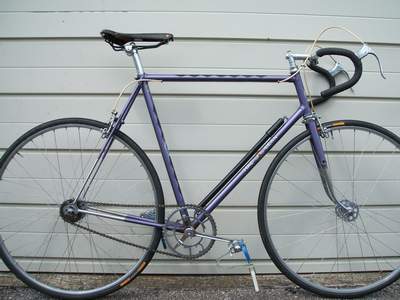
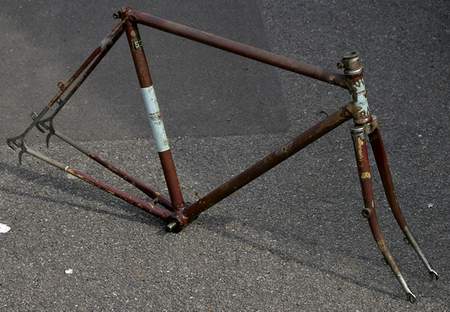
A 1956 Macleans Super Eclipse Frame No. KD 213 purchased 29.9.1956. Built with Nervex Professional lugs and Reynolds 531 tubing. This machine has the original ‘special finish’ paintwork and is seen here with fixed-wheel, Chater Lea chainset, Brooks Swallow saddle, GB stem and bars. The machine has all of the original paper-work relating to the sale.
Macleans Mac Super – by Hilary Stone
This model was listed in the immediate pre-war Maclean’s catalogue but it is not known what the lugs looked like. This frame dates from 1947 and features incredibly ornate lugs for the time. It is believed Jack Lawterwasser built frames for Macleans soon after the war, perhaps he was responsible for the development of these lugs seen below.
Mick Butler was a regular visitor to Macleans and penned the following memories:
“I only knew them in their swansong years: this would be from 1959 to the closure in November 1962. Swansong is a deliberate play on words by me as the legendary Dick Swann was shop manager there during their final years and he use to chase us out of the shop. Most of the work that was being done by the frame builders who were still working there was repairs or modifications, new tubes, modern Campag ends being fitted, and frames being re-spaced for modern gears.
They did try very hard to regain their former sales by introducing two cracking racing models in early 1960s. These were both designed by Dick Swann and were called Ultra in either Road or Track versions.
The Road Ultra was Reynolds 531 Butted Tubing with Ekla cast lugs, Campagnolo ends and Campag head and BB fittings. It had an exclusive reinforced fork crown and head lugs and seat-stay bridge.
The Ultra Track was made of Kromo tubing, again with Ekla lugs and with the reinforced crown and head, plus special rear track ends. The track had an oversize Chater BB. These came as standard with chrome fork crown and front and rear ends. Expensive but beautifully made and finished. They remained very popular for the short time they were made. In fact they were so dear that people remarked “are they gold plated for that sort of money? ” They cost in full road race kit over £90.00 then!
These remarks might have prompted N.Taylor, the then director of Macleans Featherweight Cycles, to produce a show model Road Ultra for the November Cycle Show to mark the Golden Jubilee Year of the British Cycle and Motor Cycle Industries Association. This was in a stunning gold finish and was complete with gold plated drops. It was hanging up in the window prior to the show for weeks. As kids we flocked to Upper Street just to see it.
Most of the builders finished up working on the buses after the closure: remember this was the time of the replacement of London Trolleybuses with diesel Routemasters. Most of the trolley people were ex-tramways anyway and were on a much higher rate of pay than the equivalent bus crews so they were old and either copped it and hopped it or went out on early retirement. This created many vacancies on London Transport and the bus pay was still better than frame builder’s money. Tom Board went to either Fred Deans or F.W.Evans I am not sure. Macleans then became part of Holdsworthy and they just became another Grubb, Butler, Holdsworth or Macleans – in bare metal you would never know which.
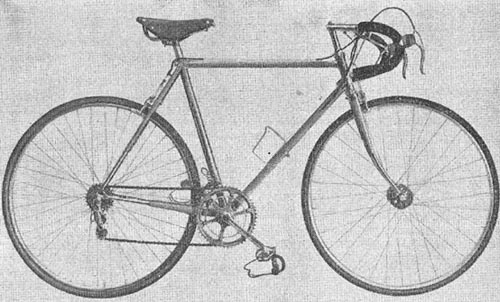

I think restarted in 1959. Anyway he was certainly at it in this year at his shop in St.Johns Hill by Clapham Junction Station because my Dad took me there. The story is that he had a picture of old man Holdsworth pasted up in the shop which he used to practice his darts on. There was certainly no love lost between the teetotaller Holdsworth and Claud who liked a drink. He must have been a right thorn in their side with his new Claud’s!
I would like to add a little bit of info to your list of frame nos. My late father bought me a second hand MacLean’s Featherweight bike for my birthday in 1962. It was frame no. KE 500 (very easy to remember). It was mainly blue with chromed forks, red white and blue bands on the saddle stem, Brookes B15 saddle and Benelux gears. I cycled round the Loire valley in France with my dad in 1963 aged 13-yrs and went on to do a lot more cycling with him! I kept the frame and eventually sold it to a chap who made a lovely job of restoring it to its former glory.
Posted: Tuesday 02nd June 2020
Contents
- Macleans Featherweight Cycles Introduction
- Adverts
- The ownership of Holdsworthy Cycles
- Frames Image gallary
- Len Phipps, owner of frame number KA996 information
- Nervex Professional lugwork
- Transfer change
- Holdsworth cycles
- Pre-war dating Information
- Macleans Super Eclipse Frame
- Macleans Mac Super
- Macleans Mac Super images
- Two cracking racing models
- Full road race kit image
- Cycling image
- Claud Butler Quote
- Reminisence
This article appears in the following categories.
Upcoming Events
Whether you are looking for a gentle social meet up, or a 100-mile ride browse the community’s upcoming events and plan your next weekend outing.

